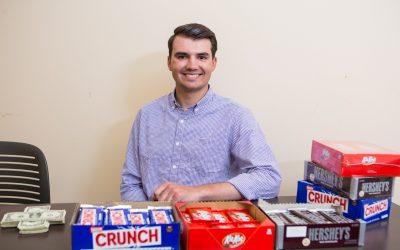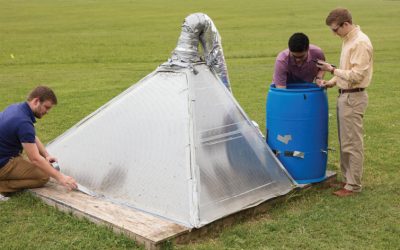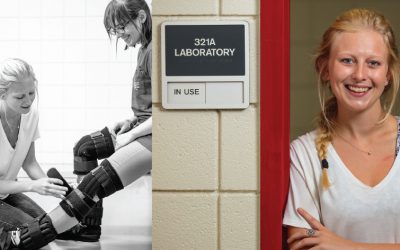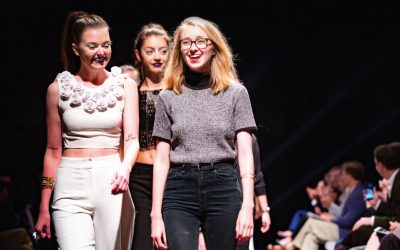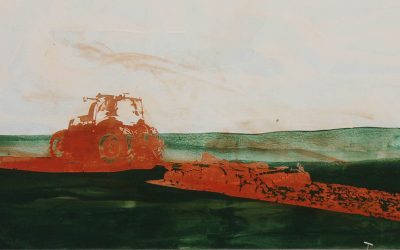As part of his biochemistry thesis, Will Pohlman developed a dye technique that may prove useful to pharmacological companies.
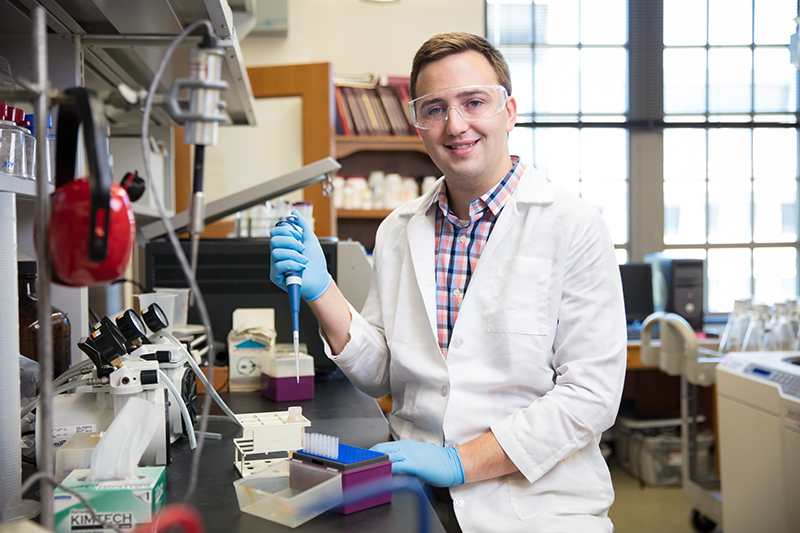
Double Duty for Future MD
Biochemistry and animal science proved to be the perfect double major for Sturgis Fellow Will Pohlman, who dreamed about a career in medicine while growing up on a cattle farm in Prairie Grove. “I ultimately hope to end up back on a farm as a practicing doctor,” he said. Pohlman found that the two disciplines meshed well, with biochemistry digging into the details and animal science providing a big picture on nutrition and public health.
Pohlman served as the Arkansas Beef Ambassador in 2014 and as a member of the National Beef Ambassador team in 2015, which afforded him a lot of contact with consumers concerned about nutrition. “People are very leery of fat, so I decided to look at what beef people choose in grocery stores, and then evaluate what they really want from a taste standpoint.”
For his first honors thesis, in animal science, Pohlman set up a multi-part survey. After completing a questionnaire exploring perceptions of beef and pricing, participants were escorted to a display case filled with packets of ground beef. They were asked to select one package from a section with labels noting fat content, and one package from a section without labels. The participants then took a blind taste test, sampling one-inch cubes of unseasoned, cooked beef patties in concentrations ranging from ultra-lean four-percent to ultra-rich 27-percent fat content.
Pohlman found that consumers preferred lean meat and were savvy in selecting low-fat packages, whether labeled or unlabeled, based on color and lightness due to fat content. The taste test provided some surprises: “The literature says the leaner you get, the less juicy, but we found that everyone was all over the board when it came to taste preferences,” Pohlman said. “Beef provides a lot of nutrients, protein, iron and vitamins, so if you can limit the fat and still enjoy the product, I say go for it.”
Being mentored by his father, Fred Pohlman, a professor of animal science, was a plus, he said, “because I could go home over the weekend, text him questions, and get a lot of work done after hours. He could also encourage me more directly, because that line of communication was already there.”
Turns out Pohlman’s background in beef proved useful in biochemistry, as well. He worked with Professor T.K.S. Kumar to purify heparin from beef tissue. Heparin is an anti-coagulant that is critically important to patients undergoing hemodialysis and those who are in hospitals for extended stays. Because heparin must currently be sourced from animals, there is a high chance of contamination, Pohlman said. Kumar had never had a student focus on heparin because he couldn’t get animal tissue, but Pohlman overcame that obstacle with a couple of phone calls.
Pohlman started with 100 grams (about 3.5 ounces) of bovine intestinal and lung tissue, converting it to a trace 322 milligrams of white powder over six days’ time. “To work with it, you have to have the stomach to handle the tissue – I had the background, the interest and the skill set to take this on and do it,” he said. There’s more work to be done – Pohlman isolated the family of compounds, but the final purification and characterization of heparin from this tissue will provide research work for future students.
As part of his biochemistry thesis, Pohlman used a dye technique to detect and measure heparin in a sample that may prove to be a cost-effective tool for pharmacological companies. He’s writing this up for submission to a journal, but the biggest pay off may be in medicine. He was accepted into five top medical schools, and will swap Razorback red for Duke blue next fall.
More Field Notes Stories
Capitalizing on Viral Videos
“There are a lot of YouTubers out there who are popular and using products spontaneously, which I believe is more powerful with Millennials.” Six students enter the Walton College Behavioral Business Research Lab, painted a soothing peach color to put them...
Pyramid Power
Garret Gardenhire, Kevin Le and Matt Annis monitor their solar-powered food dehydrator, designed to combat food insecurity in developing countries. Freshmen honors engineering students Garret Gardenhire, Kevin Le and Matt Annis inherited a simple machine and a big...
Growing Up and Growing Old: Developing Research Skills in the Aging Lab
Allen straps on a knee brace, designed to mimic the effects of arthritis on the joints; she hopes that her research will lead to a greater awareness of ageist attitudes.by Samantha Kirby “What?” I asked. “What?” My hearing was poor. I turned toward the speaker, but...
Fashion for the 21st-Century Flower Child
“They’re incredible! Katie and Laura took a dream I had and made it happen – they’ve opening up a whole new area of research for our program.” The theme was “Futuristic Floral” and the student designers rose to the challenge: the models who strutted down the runways...
Big Picture Data
“Hannah has painted something that everyone can respond to on a personal level, that offers people a way into a place to see it differently.” Rain or shine, at 7 a.m. every Tuesday for five months honors landscape architecture major Hannah Moll showed up, camera in...



